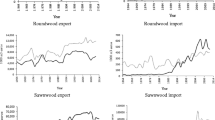Abstract
After reunification in 1990, Germany’s forest cluster developed anew and employment in the wood-based industries differentiated very quickly. With more than 900,000 employees, it is now considered one of the most important industrial sectors in the country. This paper analysed general trends in the development of employment of wood-based industries in the German forest cluster between 1999 and 2006. Shift-share analysis was considered to be the most appropriate way to determine regional differences in the subsection DD/20 ‘Manufacture of wood and wood products’ of the code “Classification of Economic Activities in the European Community, Revision 1.1” (NACE): the sawmill industry, the wood-based panel industry, the wood construction industry, the wood-based packaging industry, and the miscellaneous wood products industry. This method decomposed the change of employment into three different components that are due to that change: national trends, (industrial) sectoral trends, and regional conditions. Employment in the selected wood-based industries showed a significantly larger decrease than overall trends in both the producing industries and the whole economy of Germany: a continual loss of employees could be observed over the time period, affecting almost all of the selected wood-based industries. However, federal states in western and eastern Germany experienced divergent trends between 1999 and 2006, as different absolute and relative regional share components indicated in the shift-share analysis. This method allows of identifying regional disparities and characterising regions with positive (mainly eastern federal states) and negative (mainly western federal states) rates of employment growth. The research suggests that positive employment trends in eastern Germany’s wood-based industries can mainly be attributed to regional factors such as comparatively higher subsidies for new investments, lower labour costs, lower land values or infrastructural peculiarities.







Similar content being viewed by others
Notes
For a general profile of the eastern and western federal states of Germany, see Table 1.
References
Amend E, Bogai D (2005) Regionale Arbeitsmärkte in Ostdeutschland. Was hat das eine, was das andere Land nicht hat? IAB Kurzbericht 25/2005: p 6
Ashby LD (1970) Changes in regional industrial structure: a comment. Urban Stud 7(3):298–304
Bilek E, Ellefson P (1984) Employment in Minnesota’s wood-based industry: a shift-share analysis. Department of forest resources. Staff Paper Series 46. College of Natural Resources and Minnesota Agricultural Experiment Station, University of Minnesota, St. Paul, Minnesota, p 51. Accessed May 2007 http://fr.cfans.umn.edu/publications/staffpapers/Staffpaper46.pdf
Blien U, Wolf K (2002) Regional development of employment in eastern Germany: an analysis with an econometric analogue to shift-share techniques. Pap Reg Sci 81(3):391–414
Blien U, Blume L, Eickelpasch A, Geppert K, Maierhofer E, Vollkommer D, Wolf K (2001) Einflussfaktoren der Regionalentwicklung, Studie von IAB/DIW im Auftrag der KfW, p 75
Blien U, Haas A, Wolf K (2003) Regionale Beschäftigungsentwicklung und regionaler Lohn in Ostdeutschland. Mitt Arbeitsmarkt Berufsforsch 4:476–492
Blien U, Hirschenauer F, Hong Van P thi (2006) Model-based classification of regional labour markets. For purposes of labour market policy. IAB discussion paper. Institut für Arbeitsmarkt und Berufsforschung der Bundesagentur für Arbeit 29, p 51
Bundesagentur für Arbeit (2007) (Federal Employment Agency) Statistics of employees with social insurance registration (Statistik der sozialversicherungspflichtig Beschäftigten), Nürnberg
Bundesministerium der Finanzen (1999) Bericht der Bundesregierung über die Entwicklung der Finanzhilfen des Bundes und der Steuervergünstigungen gemäß § 12 des Gesetzes zur Förderung der Stabilität und des Wachstums der Wirtschaft (StWG) vom 8. Juni 1967 für die Jahre 1997 bis 2000, Bonn, p 244
Bundesministerium der Finanzen (2001) Bericht der Bundesregierung über die Entwicklung der Finanzhilfen des Bundes und der Steuervergünstigungen gemäß § 12 des Gesetzes zur Förderung der Stabilität und des Wachstums der Wirtschaft (StWG) vom 8. Juni 1967 für die Jahre 1999 bis 2002 (18. Subventionsbericht), Berlin, p 147
Bundesministerium der Finanzen (2003) Bericht der Bundesregierung über die Entwicklung der Finanzhilfen des Bundes und der Steuervergünstigungen gemäß § 12 des Gesetzes zur Förderung der Stabilität und des Wachstums der Wirtschaft (StWG) vom 8. Juni 1967 für die Jahre 2001 bis 2004 (19. Subventionsbericht), Berlin, p 155
Bundesministerium der Finanzen (2006) Bericht der Bundesregierung über die Entwicklung der Finanzhilfen des Bundes und der Steuervergünstigungen für die Jahre 2003 bis 2006 (20. Subventionsbericht), Berlin, p 256
Bundesministerium der Finanzen (2007) Bericht der Bundesregierung über die Entwicklung der Finanzhilfen des Bundes und der Steuervergünstigungen für die Jahre 2005 bis 2008 (21. Subventionsbericht), Berlin, p 308
Commission of the European Union (1999) Communication on the state of competitivness of the EU forest-based and related industries. Communication of the Council, the European Parliament, the Economic and Social Committee and the Committee of the Regions. COM (1999) 457, Luxembourg, p 19
Denner C (2007) Steuerungsinstrumente von high-tech Clustern. Eine Analyse auf Grundlage der Komplexitätstheorie. VDM, Saarbrücken, p 112
Dinc M, Haynes KE, Quiangsheng L (1998) A comparative evaluation of shift-share models and their extensions. Australas J Reg Stud 4(2):275–302
Dunn ES (1960) A statistical analytical technique for regional analysis. Pap Reg Sci Assoc 6:97–112
Eickelpasch A F, Pfeiffer I (2006) Standortverlagerungen in der ostdeutschen Industrie. Wochenbericht DIW Berlin 73/14: 181–185
Esteban J (2000) Regional convergence in Europe and the industry mix: a shift-share analysis. Reg Sci Urban Econ 30:353–363
Holz-Zentralblatt (2004) Konsequenzen aus verfehlter Sägewerksförderung ziehen. VDS: Subventionen für neue Kapazitäten volkswirtschaftlich nicht sinnvoll, Holz-Zentralblatt 130/50
Jaensch K, Harsche J (2007) Der Cluster Forst und Holz in Hessen. Bestandsanalyse und Entwicklungschancen. HA Hessen Agentur GmbH 712, p 109
Kies U, Mrosek T, Schulte A (2008) A statistics-based method for cluster analysis of the forest sector at the national and sub-national level in Germany. Scand J For Res 23:445–457
Knudsen DC (2000) Shift-share analysis: further examination of models for the description of economic change. Socioecon Plann Sci 34:177–198
Kramer M, Möller L (2006) Struktur- und Marktanalyse des Clusters Forst und Holz im Freistaat Sachsen und in ausgewählten Regionen des niederschlesischen und nordböhmischen Grenzraums unter den Bedingungen der EU-Osterweiterung (Cluster-Studie). Internationales Hochschulinstitut Zittau, p 200
Krätke S, Scheuplein C (2001) Produktionscluster in Ostdeutschland. Methoden der Identifizierung und Analyse. VSA-Verlag, Hamburg, p 221
Lange T, Pugh G (1998) The economics of German unification: an introduction. Edward Elgar, Cheltenham, p 240
Lebedys A (2004) Forest finance. Trends and current status of the contribution of the forestry sector to national economies (Working paper: FSFM/ACC/07). Rome: Food and Agriculture Organization of the United Nations, Forest Products and Economics Division
Ministerium für Wirtschaft, Arbeit und Tourismus Mecklenburg-Vorpommern (2005) Mittelstandsbericht Mecklenburg-Vorpommern 2002–2006, p 64
Ministerium für Wirtschaft, Arbeit und Tourismus Mecklenburg-Vorpommern (2006) Die internationale Ausrichtung der Wirtschaftspolitik Mecklenburg-Vorpommerns 2005, Außenwirtschaftsbericht Mecklenburg-Vorpommern, p 25
Mrosek T, Kies U (2006) Clustermanagement in der Forst- und Holzwirtschaft. Handlungsempfehlungen als Ergebnis der „Clusterstudie Forst und Holz Deutschland”. Holz-Zentralblatt 29: 841–843
Mrosek T, Kies U, Schulte A (2005) Clusterstudie Forst und Holz Deutschland 2005. Forst- und Holzwirtschaft hat sehr große volkswirtschaftliche und arbeitsmarktpolitische Bedeutung. Holz-Zentralblatt 84: 1113–1117
Organisation for Economic Co-operation and Development (1999) Boosting Innovation: the cluster approach. OECD Proceedings, p 428
Porter M (1998) On competition. Harvard Business School Press, Boston, p 197
Raines P (ed) (2002) Cluster development and policy. Ashgate Publishing Limited, Burlington
Sautter B (2004) Regionale Cluster—Konzept, Analyse und Strategie zur Wirtschaftsförderung. Standort—Zeitschrift für Angewandte Geographie 28/2: 66–72
Schulte A (ed) (2002) Clusterstudie Forst und Holz Nordrhein-Westfalen. Gesamtbericht. Schriftenreihe der Landesforstverwaltung NRW 17. MUNLV Ministerium für Umwelt, Naturschutz, Landwirtschaft und Verbraucherschutz, Düsseldorf, p 138. Accessed Nov 2007 http://www.forst.nrw.de/nutzung/cluster/cluster.htm
Schulte A (2003a) Nordrhein-Westfalen zieht Bilanz für Forst und Holz. Cluster-Studie weist unerwartete volkswirtschaftliche Größe der Forst- und Holzwirtschaft aus. Holz-Zentralblatt 74
Schulte A (2003b) (ed) Wald in Nordrhein-Westfalen. Aschendorff, Munster, p 1082
Schulte A, Mrosek T (2006) Analysis and assessment of the forestry and wood-processing industry cluster in the State of North-Rhine Westphalia, Germany. Forstarchiv 4:136–141
Seegmüller S (2005) Die Forst-, Holz- und Papierwirtschaft in Rheinland-Pfalz. Clusterstudie. FAWF Forschungsanstalt für Waldökologie und Forstwirtschaft Rheinland-Pfalz, Trippstadt, p 63
Sörgel C, Mantau U (2006) Strukturentwicklung der Sägeindustrie in vier Jahren. Abschlussbericht einer Studie über Veränderungen in der deutschen Sägewerkssparte auf der Basis zweier Vollerhebungen. Holz-Zentralblatt 21: 651–653
Sowlati T, Vahid S (2006) Malmquist productivity index of the manufacturing sector in Canada from 1994 to 2002, with a focus on the wood manufacturing sector. Scand J For Res 21:424–433
Statistische Ämter des Bundes und der Länder (2007) GENESIS Online. Regionaldatenbank Deutschland. Accessed Feb 2007 https://www.regionalstatistik.de/
Statistical Office of the European Communities (2002) Statistical classification of economic activities in the European Community, Rev. 1.1 (NACE). Metadata. RAMON Classification Server. EUROSTAT, Luxembourg. Accessed March 2008 http://ec.europa.eu/eurostat/ramon/index.cfm?TargetUrl=DSP_PUB_WELC
Statistisches Bundesamt Deutschland (2003) Klassifikation der Wirtschaftszweige, Ausgabe 2003 (WZ 2003). Mit Erläuterungen. Metzler Poerschel Verlag, Wiesbaden, p 860
Statistisches Bundesamt Deutschland (2007) Arbeitskostenerhebungen 2004. Arbeitskosten im Produzierenden Gewerbe und im Dienstleistungsbereich. Ergebnisse für Deutschland, Wiesbaden, p 209
Statistisches Bundesamt Deutschland (2008) Kaufwerte für Bauland und landwirtschaftliche Grundstücke. Ausgewählte Baulandarten und Länder 2006. Accesed August 2008 http://www.destatis.de/jetspeed/portal/cms/Sites/destatis/Internet/DE/Content/Statistiken/Preise/Baupreise/Tabellen/Content75/KaufwerteBaulandLaender,templateId=renderPrint.psml
Stimson RJ, Stough RR, Roberts BH (2006) Regional economic development. Analysis and planning strategy, 2nd edn. Springer, Heidelberg, p 452
Størdal S, Lein K, Orbeck M, Hagen S (2004) Regional differences in harvesting levels and wood-based employment in Norway. Small-scale forest economics. Manage Policy 3(1):35–47
Suedekum J, Blien U (2004) Wages and employment growth: disaggregated evidence for West Germany. Hamburg Institute of International Economics, Discussion paper 275, p 31
Suedekum J, Blien U, Ludsteck J (2006) What has caused regional employment growth differences in Eastern Germany? Jahrbuch für Regionalwissenschaft 26: 51–73
Tassinopoulos A (1996) Eine regionale Beschäftigungsprognose. Ergebnisse für Arbeitsmarktregionen auf dem Gebiet der alten Bundesländer. Mitteilungen aus der Arbeitsmarkt- und Berufsforschung, Sonderdruck 29: 361–377
Tesch D, Mrosek T, Schulte A (2004) Strukturen und Märkte der Sägeindustrie in NRW. Holz-Zentralblatt 90
Acknowledgments
The authors would like to thank staff members of the Federal Employment Agency (Bundesagentur für Arbeit) for helpful support in providing access to their statistical reporting system. We also thank Ms. Denise Allen, University of British Columbia, Sustainable Forest Management Research Group and Jörg Gauerke for editing the manuscript. The research was funded by the Ministry of Environmental Protection and Nature Conservation, Agriculture and Consumer Protection of North Rhine-Westphalia (Ministerium für Wirtschaft, Arbeit und Tourismus Mecklenburg-Vorpommern 2005, 2006).
Author information
Authors and Affiliations
Corresponding author
Additional information
Communicated by M. Moog.
Rights and permissions
About this article
Cite this article
Klein, D., Kies, U. & Schulte, A. Regional employment trends of wood-based industries in Germany’s forest cluster: a comparative shift-share analysis of post-reunification development. Eur J Forest Res 128, 205–219 (2009). https://doi.org/10.1007/s10342-009-0258-6
Received:
Revised:
Accepted:
Published:
Issue Date:
DOI: https://doi.org/10.1007/s10342-009-0258-6




